
Original Link: https://www.anandtech.com/show/1482
ATI Radeon X700 XT: More PCIe Midrange
by Derek Wilson on September 21, 2004 5:58 AM EST- Posted in
- GPUs
Introduction
The introduction of the X700 line (codenamed RV410), ATI is breaking their tradition of using revamped and tweaked previous generation parts in their current generation midrange product. RV410 is officially an R423 derivative. We see this as a very big step for ATI, and we hope they maintain this direction with future generations. The immediate impact on the consumer space will be better performance in the midrange and compatibility on par with high end products.
This last point is important to realize. Last year, many games or features that ran fine on 9700 and 9800 cards would have strange problems or incompatibilities with 9600 cards. Also, previous generation RV series cards lacked ATI's F-Buffer which enables GPUs to run shader programs that exceed a certain length. These issues were usually cleared up in driver updates or game patches, but attention to the midrange tended to follow attention to the high end segment. Now that the high end ATI GPU is the same core design as the midrange, any performance improvements or fixes that apply to the X800 will also apply to the X700 line.
Unlike last year (and the year before), ATI's product launches have lagged NVIDIA's. Our 6600 numbers are exactly 2 weeks old today. While some may speculate that this gives ATI an advantage because they have seen the performance of the competition, ATI needs to carefully balance yield, performance, and price for itself before it can worry about the competition. Bringing a product to market second in such a competitive space would only give ATI an advantage if they were able to maintain profitable yields at higher performance than necessary (and so could lower clocks and increase yield while still leading performance). Of course, all this goes out the window when you have NVIDIA and ATI both throwing insanely low yield high performance limited availability parts at each other trying to claim the performance crown. Hopefully we can be confident that the 6600 GT and the X700 XT will end up being less vaporous than the 6800 Ultra Extreme and the X800 XT Platinum Edition.
But all speculation aside, this is when the battle really heats up. Both NVIDIA and ATI now have affordable midrange products in the market that perform very well with respect to previous generation parts. We've got all the details inside; read on to find out who comes out on top in the most important competition for this GPU generation.
Scaling Down the X800
The basic architecture of the X700 has already been covered, as it is based on the X800's R423 core. The X700 takes it down a notch and runs with only 8 pixel pipelines at a maximum core clock speed of 475MHz on the XT version. The memory interface on the X700 series of cards is 128bit, giving it half the memory bandwidth (on a clock for clock basis) of its big brothers. Oddly, this time around there are two $200 versions of the card. The X700 XT (which we are testing today) has 475/1.05 core/mem clocks and 128MB of RAM. The X700 Pro will launch with 420/864 core/mem clocks and 256MB of RAM. We are definitely interested in testing the performance characteristics of the X700 Pro to determine if the lower clocks are able to take advantage of the larger memory to provide performance on par with its price, but for now we'll just have to settle for X700 XT numbers. ATI will also be producing an X700 card with 400MHz core and 128MB of 700MHz memory that will retail for $149.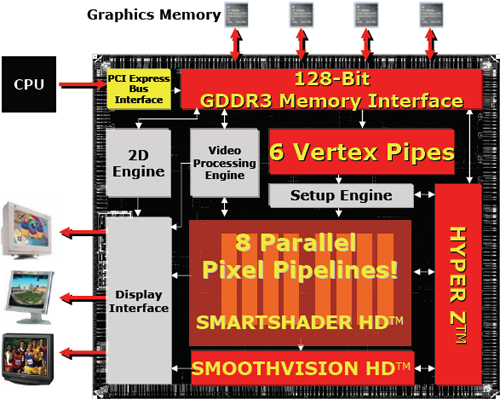
In a very interesting twist, one of the features of R423 that didn't get scaled down was the vertex engine. The RV410 GPU retains all 6 vertex pipelines. This should give it an advantage over NVIDIA's solution in geometry heavy environments, especially where an under powered CPU is involved. NVIDIA only opted to keep 3 of NV40's 6 vertex pipes. Of course, NVIDIA's solution is also capable of VS3.0 (Vertex Shader 3.0) functionality which should help out if developers take advantage of those features. Vertex performance between these midrange cards will have to be an ongoing battle as more and more features are supported and drivers mature. We will also have to come back and examine the cards on an underpowered CPU to see if the potential advantage ATI has in a wider vertex engine manifests itself in gameplay on a midrange priced system.
In addition to scaling down a few key features of the X800, ATI physically scaled down the RV410 by fabbing it on TSMC's 110nm process. This is the same process that is used in the X300 series. This isn't a surprising move, as ATI has been introducing new fab processes on cheaper parts in order to sort out any wrinkles before a brand new architecture is pushed out. NVIDIA also went with the 110nm process on this round.
Interestingly, ATI is pushing it's 110million transistors at a 25MHz lower core clock than NV43. This does give NVIDIA a fillrate advantage, though pure fillrate means very little these days. At first, we were very surprised that ATI didn't push their GPU faster. After all, RV410 is basically a cut down R423 with a die shrink. The X800 XT runs at the same core speed as the 6600 GT (500MHz). If NVIDIA could increase its clock speed from the 6800 series to the narrower and smaller 6600 series, why couldn't ATI do the same when moving to X700 from X800?
In asking ATI about this, we got quite a few answers, the combination of which generally satisfied us. First, ATI's 130nm process is a low-k process. This means that there is less capacitance between metal layers on the die, which gives ATI's GPUs added stability at higher core speeds. Shrinking to a 110nm process and losing the low-k advantage makes this different than a simple die shrink. Also, ATI's X800 series of cards are supplied with external power, while the X700 relies only on the PCIe connection for juice. This could easily explain why the X700 XT is clocked lower than the X800 XT, and the extra vertex processing power could help explain why NVIDIA was able to hit a higher clock speed than ATI. We could be wrong, but without knowing both companies' yield rates and power consumption we really can't say for sure why things ended up this way.
The X700 retains the video processing features of the X800 as well, and we are starting to see both ATI and NVIDIA gearing up for some exciting things in video. Additionally, ATI has stated that their X700 is capable of running stable passively cooled in a BTX system (albeit with a massive passive heatsink). This, of course, is something the X800 cannot do. ATI has said that initial BTX versions of their cards will be OEM only as that will be where BTX makes its first mark.
Now that we know a little more about the X700, lets take a look at the numbers.
The Test
The same general guidelines apply to this review as applied to our previous 6600 GT review. We are still comparing many PCI Express Intel system numbers to AGP 8x AMD based systems. Numbers for cards other than the 6600, X700, and X600 are run with older drivers as they are taken from previous reviews we have done. We are in the process of trying to update all our performance numbers with the latest drivers (and then some), but we were unable to do so before this review. The 6600 GT, X700 XT, and X600 XT numbers can all be reliably compared, but please use other numbers for reference only. The key thing to take away from this for most people will be the relative performance between the competing $200 ATI and NVIDIA parts anyway, so we hope that this setup won't be an inconvenience.Processor(s): |
AMD Athlon 64 3400+ |
RAM: |
2 x 512Mb OCZ 3500 Platinum Ltd (2:3: 2:10) |
Hard Drives |
Seagate 120GB 7200 RPM (8MB Buffer) |
Video AGP & IDE Bus Master Drivers |
VIA Hyperion 4.51 |
Video Card(s): |
ATI Radeon X700 XT |
Video Drivers: |
ATI Catalyst 4.6 |
Operating System(s): |
Windows XP Professional SP2 |
Motherboards: |
MSI MS-6702E (VIA K8T800 Pro Chipset) |
As previously stated, the older drivers were used in previous reviews. Only the 6600 GT, X700 XT, and X600 XT used the latest drivers. These three cards were also run on the Intel based PCI Express system, while other cards were run on AMD based AGP systems. AGP cards were run in the Athlon 64 FX 53 system for the Doom 3 and Source Engine tests and all other AGP cards were tested in the 3400+ system.
We wanted to include Aquamark 3 numbers, but we were unable to get the X700 XT to get to the point where it would spit out a number for us. The test ran all the way through, but just didn't display the score. This is probably just some error on Aquamark's part as it gets through the entire benchmark just fine every time.
We should also mention that we did not use the Catalyst Control Center for these tests as we did not want to install the .NET Framework on our test system. All the functionality of the driver is there with the exception of being able to disable certain optimizations that ATI is now rolling into a package called Catalyst AI (which we will talk more about in a seperate article). Thus all the default Catalyst AI settings are used, and our standard control panel setup is used (all defaults with vsync disabled).
Doom 3 Performance
There really isn't any contest here, as the 6600 GT is ahead in every test. This is an OpenGL game and NVIDIA hardware leads at the high end as well, so this was to be expected. The X700 does put in a good show compared to the rest of the pack.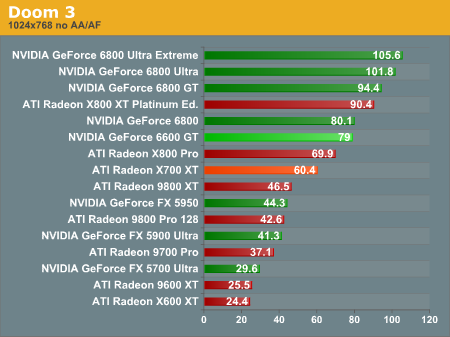
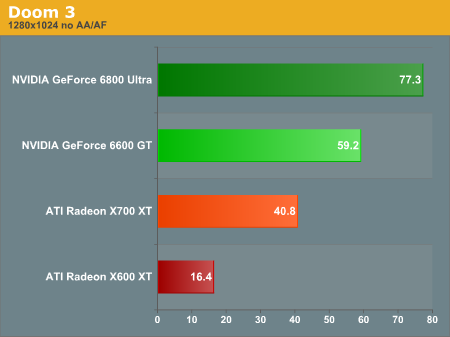
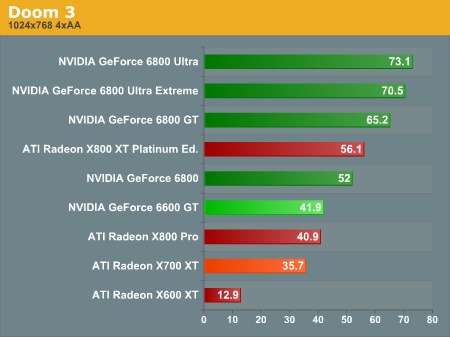
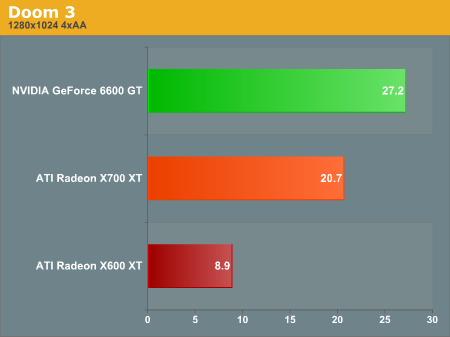
FarCry Performance
In this benchmark, we see something quite different than we are used to: ATI leads when AF and AA are disabled, and NVIDIA takes over when the settings are cranked up. The Radeon X700 XT takes a rather intense performance hit when 4xAA and 8xAF are enabled in FarCry. We did use the in game settings on all cards involved in this benchmark.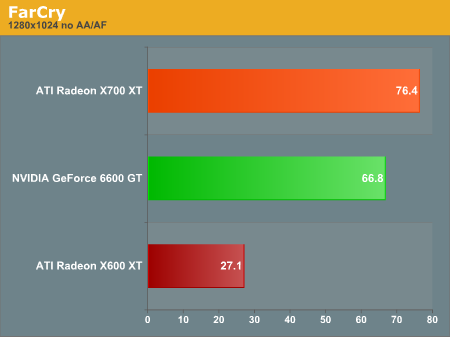

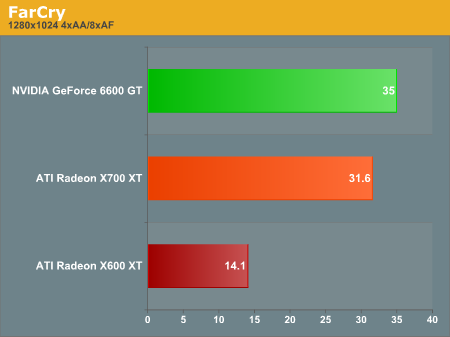
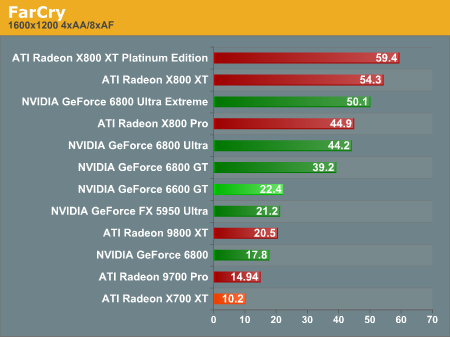
Halo Performance
Under Halo, the Radeon X700 XT falls behind the GeForce 6600 GT at 1280x1024 (and above) with 8xAF enabled. Halo does not allow antialiasing, so we only ran two tests with this benchmark.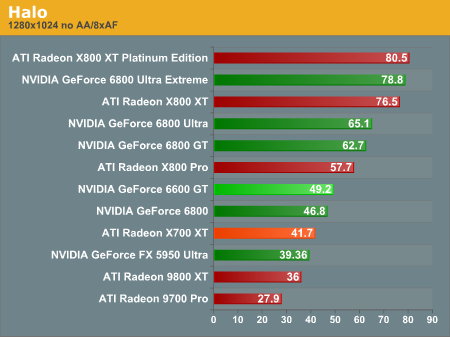
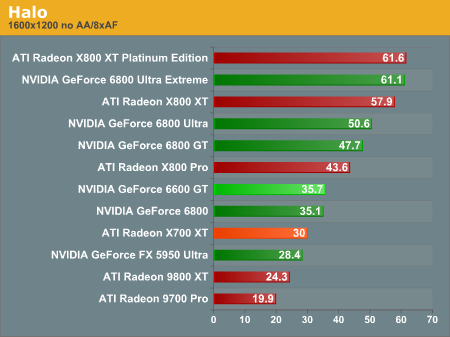
Jedi Knights: Jedi Academy Performance
NVIDIA hardware owns this benchmark, so it's no surprise that the 6600 GT leads the X700 XT in all the Jedi Academy tests. As Doom 3 is our modern OpenGL test, this benchmark tests performance on DX7/8 class OpenGL software.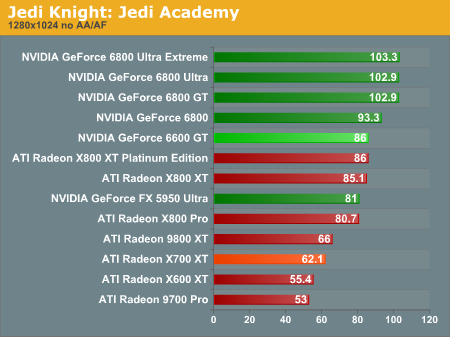
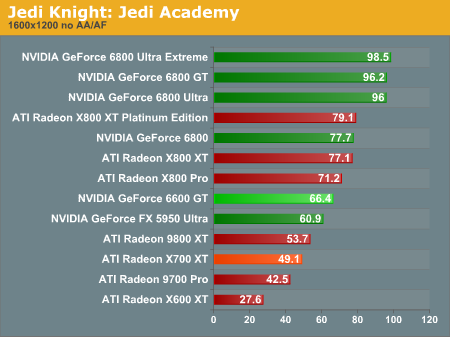
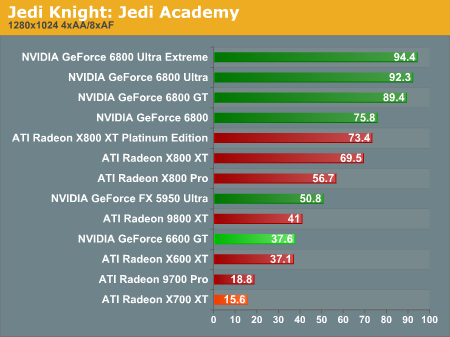
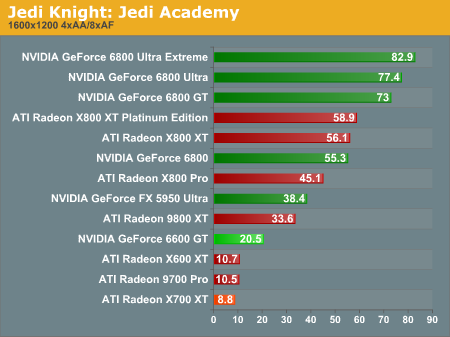
Source Engine Stress Test
While the Radeon X700 XT maintains a lead in 3 out of 4 tests with the Source Video Stress Test (at upto 32% in the 12x9 4xAA/8xAF test), the GeForce 6600 GT is more resilient as resolution increases and when AA and AF are enabled. Since we see less varience in the 6600 GT numbers, it ends up taking a 26% lead when we run 16x12 4xAA/8xAF. From this test, it looks like the X700 is the better card for source based games unless you want to run at really high quality settings.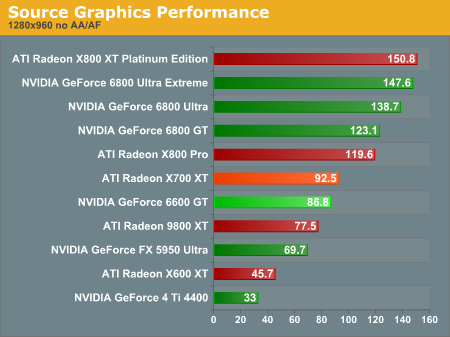
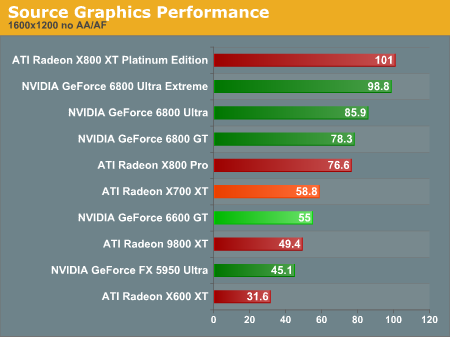
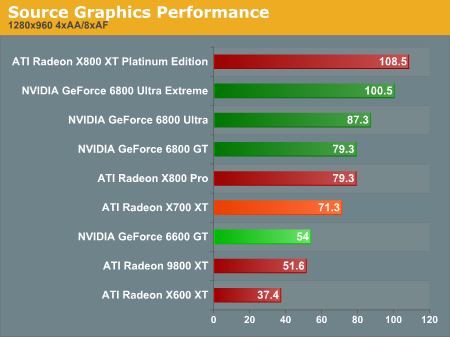

Unreal Tournament 2004 Performance
In our modern DX8 test, it seems the X700 finally finds a game that it can handle running AA and AF on. This is the only game that the X700 beats the 6600 in both AA/AF enabled tests (though it is edged out in tests without these options enabled).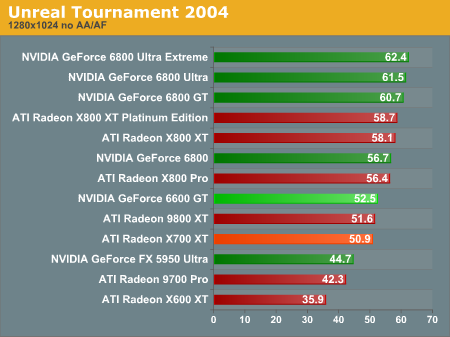
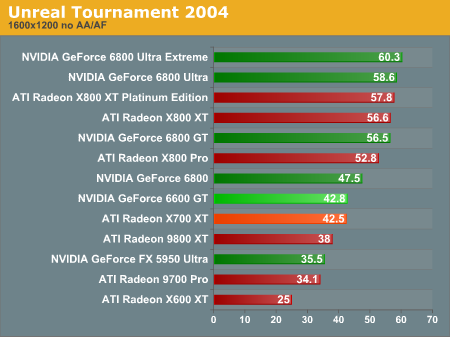
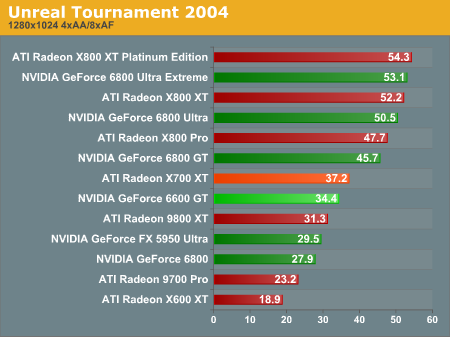
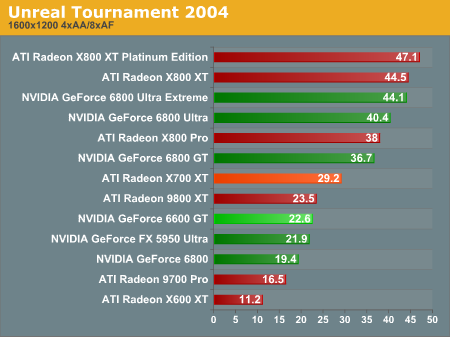
Final Words
As we have seen from our tests, the X700 XT packs a lot of punch into a small package. Most of the time its not quite enough to keep up with the NVIDIA 6600 GT, but the X700 XT proves its worth in the Source Engine Video Stress Test, and FarCry, and Unreal Tournament 2004. Most of the X700 XT's power shines through when anisotropic filtering and antialiasing are disabled (the exception being UT2K4). Current and previous generation OpenGL titles do show the Radeon X700 XT lagging the NVIDIA GeForce 6600 GT. NVIDIA has traditionally been stronger in OpenGL performance than ATI, so this is not really a surprise.What is interesting is that we usually see ATI cards push past NVIDIA cards when aniso and antialiasing are enabled, but we are seeing the reverse this time around. This could be because NVIDIA has finally got a solution with the same number of pixel pipes at a higher core clock speed than a comparably priced ATI product. The NVIDIA part also seems to maintain performance a little better when its limits are pushed (i.e. at 1600x1200). This could indicate that NVIDIA is making more effective use of memory bandwidth, as the 6600 GT is actually running at a very slightly slower memory data rate.
It is possible that we are only seeing the X700 XT pull further ahead at lower resolutions and when AA and AF are disabled because geometry processing is a larger percentage of overall performance in those cases, but we don't have a very sound way of testing this at the moment. We have also not explored the impact of coupling these GPUs with a lower performing CPU. The added geometry processing power of the X700 XT may or may not help alleviate the strain on slower systems, though it doesn't seem likely that this would be a significant advantage.
In addition to it's other advantages, the NVIDIA GeForce 6600 GT is capable of being used in an SLI configuration. Whether or not this will prove to be worth the investment is still up in the air (we still don't have that bridge connector from NVIDIA), but certainly it poses a potential that ATI can't offer right now.
In the end, the GeForce 6600 GT is a more versatile solution than the Radeon X700 XT that can deliver higher performance at more demanding settings. The X700 is certainly not a bad card, and street prices still remain to be seen. At publication, we found a 6600 GT available for $209 on pricewatch, though street prices for the X700 are not yet available. Unless the X700 XT is priced comfortably below its $199 MSRP, or you need the 256MB of the X700 Pro, the 6600 GT is the way to go for midrange cards.







